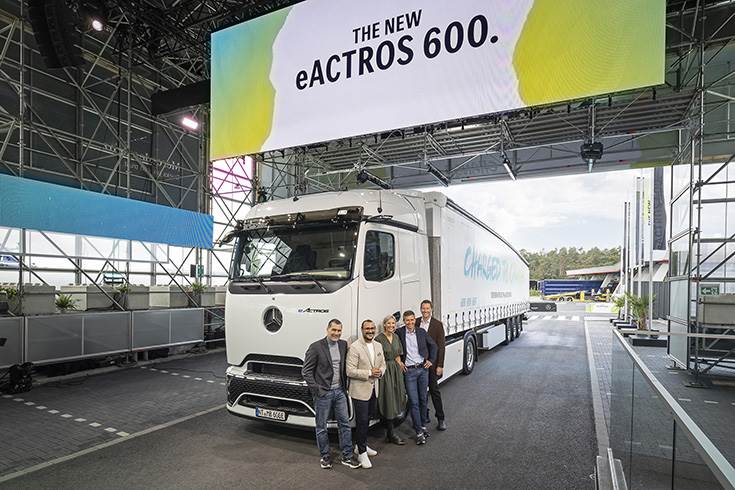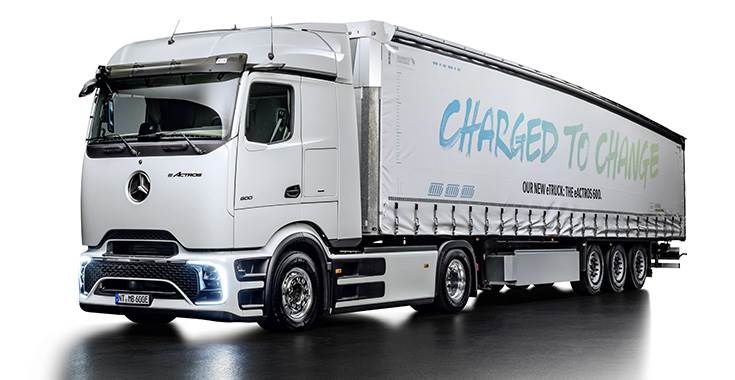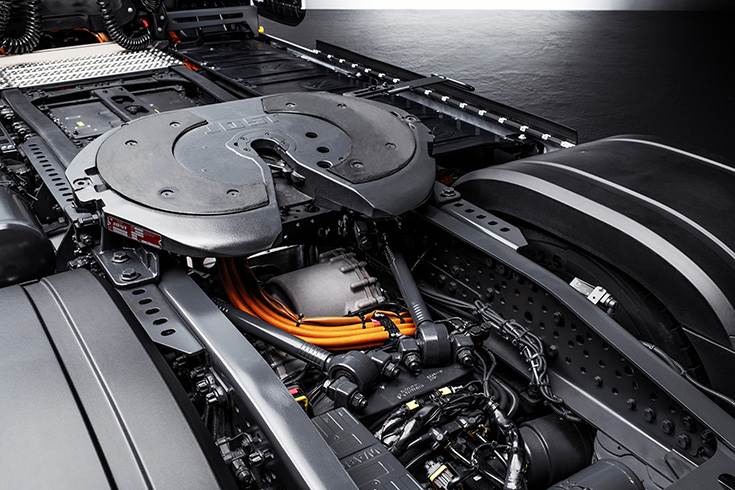Mercedes-Benz Trucks has unveiled the series version of the first battery-electric long-haul truck with the three-pointed star – the Mercedes-Benz eActros 600. With this heavy-duty electric truck, the manufacturer plans to define the new standard in road freight transport – in terms of technology, sustainability, design and profitability for e-fleet operators.
The high battery capacity of more than 600 kilowatt hours – hence the model designation 600 – and a new, particularly efficient electric drive axle developed in-house, enable the e-truck to achieve a range of 500 kilometres without intermediate charging. Therefore, the eActros 600 will be able to travel significantly more than 1,000 kilometres per day. This is made possible by intermediate charging during the legally prescribed driver breaks – even without megawatt-charging. Around 60 percent of long-distance journeys of Mercedes-Benz Trucks customers in Europe are shorter than 500km anyway, which means charging infrastructure at the depot and at the loading and unloading points is sufficient in such cases.
For all other uses, continual expansion of public charging infrastructure is vital in order to make the electric truck viable for long-distance haulage across Europe. In addition to CCS charging with up to 400 kW, the eActros 600 will later also enable megawatt charging (MCS). As soon as MCS technology becomes available and is standardized across manufacturers, it is planned to be retrofittable for these models of the eActros 600. The batteries can be charged from 20 to 80 percent in about 30 minutes at a suitable charging station with an output of around one megawatt.

Efficient LFP battery technology
The eActros 600 has three battery packs, each with 207 kWh. These offer an installed total capacity of 621 kWh. The batteries are based on lithium iron phosphate cell technology (LFP) and are characterized by a long service life. The development engineers at Mercedes-Benz Trucks have designed the eActros 600 to meet the same requirements on the durability of the vehicle and components as a comparable conventional heavy-duty long-haul Actros. That means up to 1.2 million kilometres in 10 years of operation. After this period of use, the battery state of health should still be over 80 percent. Moreover, in contrast to other battery cell technologies, approximately 95 percent of the installed capacity can be used with LFP technology. This makes a higher range with the same installed battery capacity possible.
The vehicle is technically designed for a gross combination weight of up to 44 tons. With a standard semitrailer, the eActros 600 has a payload of around 22 tons in the EU.
Visually, the e-truck is characterized by a fundamentally new, puristic design with clear lines and an aerodynamic shape. When it comes to profitability for fleet operators, the electric truck is intended to set new standards, over the long term replacing the majority of diesel trucks in the important long-haul transport segment.
Sales of the electric truck start this year. The start of series production is planned for the end of 2024. In addition to the tractor unit, Mercedes-Benz Trucks will also produce rigid variants of the eActros 600 right from market launch, offering customers further possible applications for all-electric transport. A fleet of around fifty prototype vehicles is currently being built, some of which are also to be put into practical testing with first customers in a next step.
Karin Radstrom, CEO Mercedes-Benz Trucks, said: “The eActros 600 stands for the transformation of road freight transport towards CO2-neutrality like no other truck with a three-pointed star. It is characterized by highly innovative drive technology that can offer our customers particularly high energy efficiency and thus profitability. This makes entry into e-mobility even more attractive for fleet operators.”

More than 80% CO2 savings possible vs diesel trucks over entire lifecycle
The CO2 footprint of the eActros 600 depends heavily on the electricity mix used for driving operation. With the current European energy mix, the eActros 600 achieves CO2 savings of around 40 percent compared to a comparable diesel Actros and, with fully renewable energies, of more than 80 percent over the entire product lifecycle of 10 years from raw material extraction. This corresponds to savings of around 370 or 775 tons of CO2. As a result, the eActros 600 can compensate for the higher CO2 footprint ex works due to its batteries within its second or first year of operation in long-haul transport.
Predictive Powertrain Control in the eActros 600
Mercedes-Benz Trucks has developed a new 800-volt electric axle with two electric motors and a four-speed transmission specifically for use in heavy-duty long-haul transport. The electric motors generate a continuous output of 400 kW as well as a peak output of 600 kW and ensure powerful acceleration, high driving comfort and high driving dynamics. The full motor output is available most of the time with almost no interruption in torque.
In addition, with an anticipatory driving style, electrical energy can be recovered through recuperation, which is fed back into the batteries of the eActros 600 and is then available again for the drive system. Recuperation puts less strain on the brakes of the eActros 600, which is a positive side effect. Depending on the situation, the driver can choose between five different recuperation levels. One-pedal driving can also be optionally enabled on the touchscreen in the digital cockpit – i.e. deceleration by means of recuperation with reduced actuation of the mechanical brake.

The eActros 600 features the tried-and-tested Predictive Powertrain Control (PPC) cruise and transmission control, which is specially tuned to the electric drive system. The anticipatory drivetrain control automatically takes into account the topography, course of the road and traffic signs for the most efficient style of driving. Route information from the navigation system is now included to facilitate better recognition of the situation on the road ahead. This allows the driver to avoid unnecessary braking, accelerating and shifting and to exploit the battery energy as efficiently as possible.
Via the Multimedia Cockpit Interactive 2 installed as standard in the eActros 600, the driver is continuously informed about the charge level of the batteries, the remaining range as well as the current and average energy consumption. Fleet managers can use digital solutions for efficient management of their fleet via the Fleetboard Portal. These will, right from the start, include an individually developed charge management system, such as smart control of all processes between the eActros 600 and the charging infrastructure, as well as a logbook with detailed information on driving, standing and charging times as well as consumption data. There will also be a mapping tool that shows in real time where a vehicle is currently located, whether it is driving, stationary or charging, and how high the battery charge level is.
